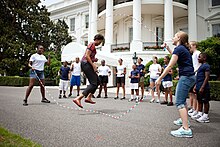Double Dutch (jump rope)

Double Dutch is a game in which two long jump ropes turning in opposite directions are jumped by one or more players jumping simultaneously. It is believed to have originated among Dutch immigrants in New York City, and is now popular worldwide.[1] While it had long been a popular street activity for African American girls in New York City,[2] the modern sport of Double Dutch originated in the early 1970s with NYPD officers and , who formalized the rules for competition. The first official competition was held in 1974. Competitions in Double Dutch range from block parties to the world level. During the spring of 2009, Double Dutch became a varsity sport in New York City public high schools.[3]

In the early 1980s, Double Dutch was strongly associated with New York hip hop culture.[4] It has also been recognized as an element of the genre by notable MCs such as KRS-One.
Technique[]

Playing Double Dutch involves at least three people: one or more jumping, and two turning the 3.5 m-long (11.5 ft) ropes (according to the American standard). A jumper usually performs tricks that may involve gymnastics or breakdance, and may also incorporate fancy foot movements.
In popular culture[]
The 1981 single "Double Dutch Bus" by Frankie Smith features African American girls playing this game in the video clip of the song.[5]

The 1983 single by Malcolm McLaren, "Double Dutch" features a number of New York City troupes. It is taken from his debut album Duck Rock.[6]
Doubletime, a documentary from Discovery Films, tells the story of the historic meet-up of rope skipping and Double Dutch. The film follows two top teams, the Bouncing Bulldogs and the Double Dutch Forces, as they train to compete against each other for the first time. The competition took place at the Apollo Theater in Harlem.[7]
The 2002 novel Double Dutch by Sharon M. Draper features a teenager competing in the Double Dutch world championships.

In 2005, Elizabeth Verity, also known as Double Dutch Girl, exhibited her technique around the United States, raising money for the United States military. Double Dutch Girl jumped rope in St. Louis, Chicago, Washington and several small towns throughout the Midwest. Ultimately, her goal is to jump rope in all 50 states.[8]
The 2007 Disney Channel original movie Jump In! features Double Dutch as the central element of its plot.
In 2010, Saltare was on season 5 of America's Best Dance Crew and the group featured single rope and Double Dutch into their dance routines.[9][10]
A 2010 PBS documentary, New York Street Games, included Whoopi Goldberg describing Double Dutch.[11]
On January 15, 2007, in honor of Martin Luther King Jr. Day, the Google homepage featured a double Dutch logo with black children playing with white and Asian children, emblematic of the realization of Martin Luther King Jr.'s "I Have A Dream" speech in 1963.[12]
Double Dutch is featured in the Wee Sing production Grandpa's Magical Toys.[13]
In his dual title role of the 2011 movie Jack & Jill, Adam Sandler gives a demonstration of Double Dutch jump rope on board the cruise liner.[14]
Competitive play[]

The National Double Dutch League holds yearly camps and a Holiday Classic, in which teams from all over the world compete. Double Dutch is also an integral part of USA Jump Rope Tournaments as well as the AAU Junior Olympic Games and the World Jump Rope Federation's worldwide annual competitions.
The World Jump Rope Championships were held in July, 2012, at George Washington University, in Washington D.C.[15][16]
Double Dutch competitions are categorized as compulsory, freestyle, and speed rope.
In France[]
Double Dutch is associated with early French hip-hop scenes. It was introduced in late 1982 when the World Champion Fantastic Four Double Dutch team came to France along with the New York City Rap Tour. Groups such as the Dutch Force System were some of the better-known Double Dutch groups. Double Dutch was seen as "the symbol of a strong and affirmed femininity in hip-hop".[17]
References[]
- ^ Jamin Brophy-Warren (9 November 2007). "Bested by Japan, A Jump-Rope Team Plots a Comeback". WSJ. Retrieved 31 December 2016.
- ^ https://aaregistry.org/story/double-dutch-fun-and-great-exercise/
- ^ Hu, Winnie (31 July 2008). "Double Dutch Gets Status in the Schools". New York Times. Retrieved 31 December 2016.
- ^ Lauren Schwartzberg, Double Dutch's Forgotten Hip-Hop Origins, vice.com, April 1, 2015
- ^ "Frankie Smith – Double Dutch Bus (Official Music Video)". YouTube. Retrieved 16 January 2018.
- ^ "Malcolm Mclaren Presents Double Dutch". YouTube. Retrieved 16 January 2018.
- ^ "Doubletime (2007)". IMDB. IMDB. Retrieved 16 January 2018.
- ^ "Archived copy". Archived from the original on 2010-04-10. Retrieved 2010-04-07.CS1 maint: archived copy as title (link)
- ^ "Saltare". USA Jump Rope. Archived from the original on 2012-06-28.
- ^ Goodtree, Hal. "Morrisville's Saltare on America's Best Dance Crew". carycitizen.com. Archived from the original on 2012-10-19.
- ^ Hector Elizondo (Narrator); Matt Levy (Director). New York Street Games (Motion picture). New York City. Archived from the original on 2011-11-13. Retrieved 14 Nov 2011.
- ^ Google MLK Day logo
- ^ "Wee Sing Grandpa's Magical Toys". Wee Sing. Penguin Group. Retrieved 16 January 2018.
- ^ "Clip from Jack and Jill movie". YouTube. YouTube. Retrieved 16 January 2018.
- ^ Kelly, Brian. "Bainbridge jumpers win gold medals at world championship". bainbridgereview.com.
- ^ Owens, Dave. "World Jump Rope Championships Unlike Jumping Rope In Your Backyard". WUSA 9. Archived from the original on 2014-07-02. Retrieved 2012-08-23.
- ^ Piolet, Vincent (June 2015). Regarde ta jeunesse dans les yeux: naissance du hip-hop française, 1980-1990 (in French). France: Horizon. p. 90. ISBN 9782360541676.
Further reading[]
- Veronica Chambers, Double Dutch, ISBN 978-0-7868-0512-9, Jump At The Sun; 1 edition (October 14, 2002)
- Kyra D. Gaunt, The Games Black Girls Play: Learning the Ropes from Double-Dutch to Hip-hop, ISBN 0-8147-3120-1, Published 2006 NYU Press
External links[]
- Girls' toys and games
- Games of physical skill
- Aerobic exercise